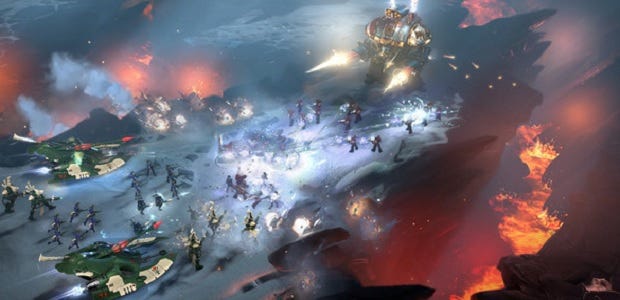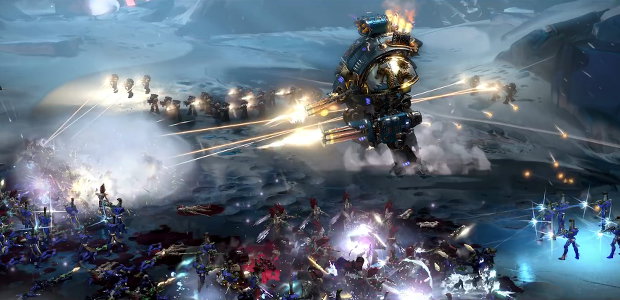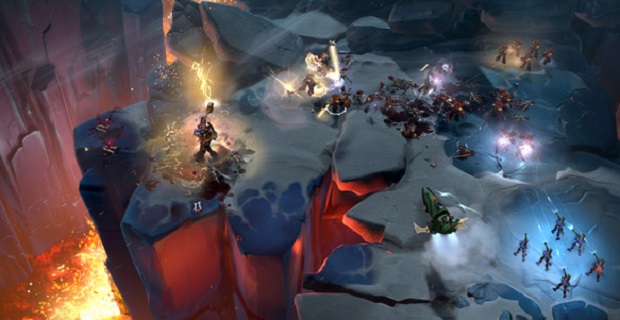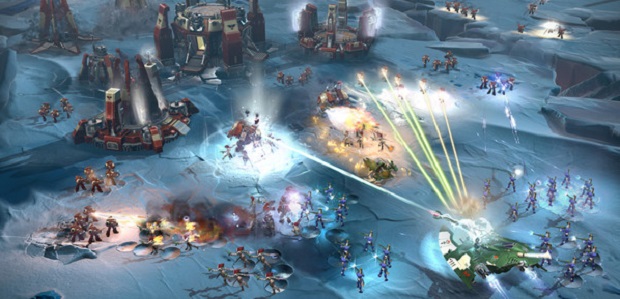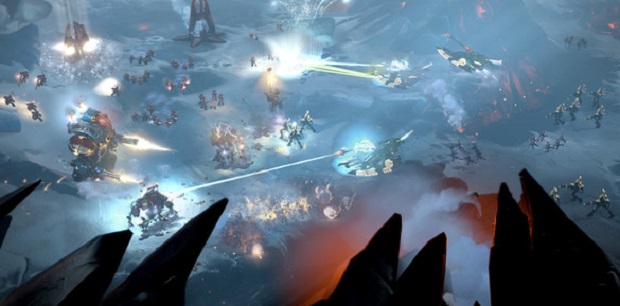Colour & Chaos: Exploring The Art And Mechanics Of Warhammer 40,000 Dawn Of War III
Grimbright
I’ve never seen anything quite as Warhammer 40k as the fire that rains from the sky when Relic’s representative calls in orbital bombardment on an Eldar army. It’s like the finger of an extremely angry god, a column of flame that can be dragged around the planet surface, disintegrating any unit that it touches. Eldar become brittle silhouettes, elevated by the white heat for a moment as if undergoing a warped Ascension, and then they crumble to ash. This is Dawn of War III [official site] and it's hideous, awesome and garish.
Despite the planet-shattering power of that weapon, I’m most taken aback by how colourful the whole scene is. This is a Blood Raven assault on a planet of ice and fire, and it’s extremely violent, with assault squads taking flight and screaming across the map to tear their enemies apart, and a forty foot tall Imperial Knight combat walker crushing everything in its path, or indeed its line of sight. It’s not grimdark though, and that’s not only because of the bright colours. There are heroes here, in the form of Gabriel Angelos, who fights alone against overwhelming numbers before backup arrives, and in the pilot of that Imperial Knight, Lady Solaria.
Rather than keeping the focus of Dawn of War III on these heroic units though, Relic are attempting to bring together the best parts of both of the game’s predecessors. Base-building, dropped in II, is back, but leaders with overpowering abilities are a major part of the game as well.
The second game emphasised the importance of cover and the new/old way of dealing with that is the one mechanic I’ve seen that I’ve yet to be convinced about. Cover is no longer directional, as in the second game, so instead of hiding behind walls or other environmental objects, squads can be placed within protective bubbles. That protects them from attacks coming from any side, but can be destroyed and does not provide any security against melee units that might infiltrate. Hence the importance of assault marines that can zip across the map - and most obstacles - using their jump packs.
It’s a simplification, providing a protective umbrella rather than actual lines of cover, and it might be that it improves the flow of territorial gain and entrenchment, placing a greater focus on the composition of forces rather than the specifics of the terrain. That’s not to say terrain won’t matter: in the mission I saw,much was made of bottlenecks around strategic points, as well as the use of unit-specific abilities to traverse otherwise impassable areas. The changes to cover reduce positional micromanagement and that appears to be a way to allow the player’s attention to be focused on the correct use of units and their skills.
When the demonstration begins, Angelos is alone and Dawn of War III resembles an ARPG. He’s massive, this Blood Raven, towering over Eldar troops. One of the most remarkable things about Dawn of War III is how accurately the units resemble their physical counterparts. I saw a Fire Prism tank at one point and could almost see the chipped paint on a model I owned decades ago. I hadn’t thought of it for years and suddenly I could see it vividly, purple and silver, with a Ziggy Stardust motif running along the curve of its turret.
Eldar should be glam.
And in Dawn of War III they are. Or if not fully glam, they’re at least colourful enough to pop out of the scenery. Then again, so are the marines. This is almost like Warhammer as a Saturday morning cartoon and it looks wonderful in motion. When I spoke to game director Philippe Boulle, I was keen to learn more about the importance of making a battlefield so packed with action - and screens filled with units of such varying scales - legible at all times.
“Internally, we create levels of spectacle and visual intensity. We consciously decide what level something is supposed to be. So something like passive bolter fire you should notice in a small engagement but it shouldn’t drown out everything else and it can fade into the background in a larger confrontation where it’s less important. The lascannons generate a lot of damage, particularly when they stay focused, so they’re a lot brighter onscreen, and build in intensity.
"Grenades are a good example of how we’ve changed our visual design over the years. You’ve been able to throw grenades since the dawn of Dawn of War. Generally you throw a grenade with one guy. Maybe there’s some smoke and maybe there’s a countdown then a big explosion. We spent a lot of time making the tell of the grenades a lot clearer.
"The more important something is for gameplay, the more attention-setting it needs to be. The orbital bombardment is the most attention-grabbing thing on-screen, visually and in terms of gameplay. It’s appropriate that it drowns out everything else. The chaos of battle is part of these big RTS games. At first glance it looks like there’s all kinds of stuff happening but because it’s introduced over the course of the game, you have plenty of time to learn the animation tells and visuals of different attacks and elements of the maps.”
My interest in all of that colour and light goes deeper though. My knowledge of 40k lore isn’t particularly strong; everytime I need to educate myself about a particular part of the universe, I end up trapped in the Lexicanum, clicking on the random page selector. I did it just now and ended up reading about the Months of Shame. Lovely stuff.
But I want to know about Relic’s relationship with the setting and with Games Workshop. What kind of stories can they tell and what kind of stories do they want to tell, within their games about war set in a world of war?
“The fundamental relationship with Games Workshop hasn’t changed, they’ve been great partners over the years and we’ve built a level of trust with them,” Boulle explains. “It’s important not to be overly precious about the setting. One of the great services Games Workshop provide is that they are stewards of their IP and if something doesn’t quite work, they’ll gently remind us and find a solution.
“That said, getting the grimdarkness of the world is so important,” says Boulle. “I came to Relic to work on Dawn of War games. I will say that at times the IP is so rich that it can come across as a barrier to play. The wall of lore, I call it. You have to read tomes and tomes in order to understand what’s going on.
"To avoid that, we identify the things that we fell in love with to begin with. Twenty five years ago I fell in love with an image in White Dwarf of a Space Marine, without knowing the story behind it. I didn’t know what a Space Marine was, or how it worked, or what the world it existed in was like.
"The elite heroes allow us to encapsulate the cool aspirational aspects that stand out against the backdrop of eternal war. There are also cool things to do narratively - if you’re fighting the same wars from one generation to the next, how do you be a hero?”
By using a gatling gun or a barrage of missiles, judging by what I see during the battle against the Eldar. One thing that stands out is that special attack used by hero units do seem to allow some fine control. Whether you’re using a teleport-dash to relocate on the battlefield or directing the individual missiles in a cluster toward targets, a couple of seconds of close attention might improve your odds of dealing a lethal blow to your targets.
Even the marines reinforcements, arriving in drop pods as they always have, can benefit from your attention. Rather than simply scattering them around the field, you can utilise them as weapons, crushing enemies with the pod as they THWOMP onto the planet’s surface.
I’m curious as to whether changes to the actual ruleset of 40k over time have any influence on the design of a new Dawn of War game, particularly given the importance of specific skills and the apocalyptic weaponry on display.
“There are points of inspiration taken from rulesets. They’re very different games because there’s almost no randomness under the hood in Dawn of War, whereas 40k tabletop does have dice involved. But whenever there are new abilities introduced, that becomes part of the pool of inspiration. Some of what’s fun about translating the tabletop into the digital space.”
The visual ‘pop’ that caught my eye from the first seconds of the demonstration calls back to the tabletop game as well, Boulle reckons: “Colourful armour against a dark world has always been part of 40k. It goes back to the themes we were talking about earlier, heroes standing against the dark setting.
“We looked at how to make units recognisable on the field of battle. Dawn of War II had lots of scratches on armour and the up close feeling. Scaled out with larger enemies we have to make sure that every unit pops out. So we think about how the best model painters treat their models - you can’t translate directly because light works differently in a digital space, but is’ a helpful starting point. All art decisions are based on legibility as well as emotional and thematic weight.”
With its three factions - Orks and Eldar join the Marines - offering a “triangle of contrasts, both in terms of narrative and mechanics”, Dawn of War III should have plenty of variety in its armies. Three factions might not seem like a big haul but every unit in the demonstration has at least one very specific application. What the game needs is a campaign that’s equal to that variety. We’ll hopefully learn more about that soon but, for now, I’m pleased to see that Relic really do look to be taking the best of both of their previous dawns.
Dawn of War III will be out next year.
